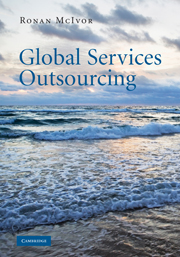Book contents
- Frontmatter
- Contents
- List of figures
- List of tables
- List of illustrations
- Acknowledgements
- 1 Introduction
- 2 Global services outsourcing overview
- 3 Making the services outsourcing decision
- 4 Location and sourcing model choice in global services outsourcing
- 5 Managing global services outsourcing arrangements
- 6 Creating shared services arrangements
- 7 Services outsourcing and performance management
- 8 Services outsourcing and the spin-off arrangement
- 9 Learning from failure and strategies for recovery in business process outsourcing
- 10 Conclusion
- Glossary
- Index
- References
7 - Services outsourcing and performance management
Published online by Cambridge University Press: 05 June 2012
- Frontmatter
- Contents
- List of figures
- List of tables
- List of illustrations
- Acknowledgements
- 1 Introduction
- 2 Global services outsourcing overview
- 3 Making the services outsourcing decision
- 4 Location and sourcing model choice in global services outsourcing
- 5 Managing global services outsourcing arrangements
- 6 Creating shared services arrangements
- 7 Services outsourcing and performance management
- 8 Services outsourcing and the spin-off arrangement
- 9 Learning from failure and strategies for recovery in business process outsourcing
- 10 Conclusion
- Glossary
- Index
- References
Summary
Introduction
Outsourcing is increasingly being employed to achieve performance improvements across the entire business. However, many organisations have had mixed results with outsourcing, and have failed to achieve the desired performance improvements. Some have argued that organisations have not understood fully the implications of outsourcing and performance management. Organisations have outsourced poorly performing processes without understanding the causes of poor performance. Services providers often cannot deliver the required performance improvements because of poorly designed processes or the idiosyncratic requirements of clients. Organisations also have difficulties assessing vendor performance during the outsourcing relationship, as they have not established effective performance measures for the process prior to outsourcing.
This chapter focuses on performance management and the outsourcing process. A framework is presented which provides an outline of the stages involved in integrating performance management into the outsourcing process. The framework employs a number of performance management techniques including cost analysis, benchmarking, workflow mapping and continuous improvement. The chapter is structured as follows. Initially, an overview of the relationship between outsourcing and performance management is presented. This is followed by a detailed description of a framework for integrating performance management into the outsourcing process. Illustrations from a financial services organisation (FSO) are introduced throughout the chapter to demonstrate the practical implications of performance management for the outsourcing process. The challenges and benefits of performance management and outsourcing are outlined. Finally, summary implications are presented.
Information
- Type
- Chapter
- Information
- Global Services Outsourcing , pp. 182 - 213Publisher: Cambridge University PressPrint publication year: 2010
